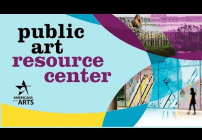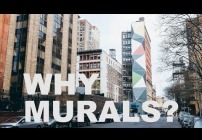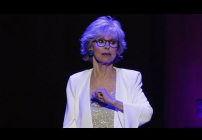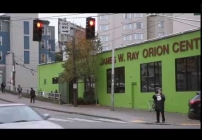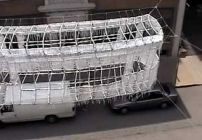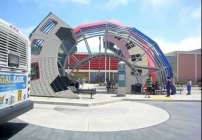This Neighborhood Is...:Portraits of Culliton Park Neighbors
PROJECT OVERVIEW

Osmyn Josef Oree www.osmynjoree.com [email protected]
“This Neighborhood Is…” was installed along the façade of the Water Street Mission building. The mural was a compilation of answers provided by the Culliton Park neighborhood. Folks were invited to finish the sentence “This neighborhood is…” however they wanted. They were then invited to sit for a portrait and participate in the installation of the final piece. Over three days in mid-September we installed twenty portraits and twenty-five responses on the Mission wall. Volunteers from the community assisted in wheat-pasting, prepping, and painting, various parts of the project. Folks who sat for portraits were invited to come for free lunch and a free print of their portrait as an expression of gratitude for their willingness to be part of the project. During the installation of “This Neighborhood Is…”, participants expressed that the project broke down barriers between folks that live in the neighborhood, folks that use the park as home, and folks in transition. They felt that the regular and consistent presence of art in the park helped encourage more families to come out and engage their neighbors. Ultimately, I envision a new phase of my work engaging more directly with questions of belonging and visioning what an intentional, inclusive, and accessible future looks like for the neighborhood while also honoring what has happened here.
The mural was the final product of a 4 months of community engagement around the upcoming renovation of a neighborhood park. The first phase of community engagement in Culliton Park consisted of four key elements: free pop up arts and crafts in the park, a community zine making and pizza party day, a temporary community mural, and a series of small public art projects. “Art Pop” was offered throughout the summer mostly on weekends. It featured a tent painted to resemble a circus tent, a table, and supplies for a variety of arts and crafts projects. Anyone was invited to come to the table, sit down, and make something to take with them or hang on the chain-link fence that borders the park. “Art Pop” was a result of feedback I gleaned from the community. Many parents were weary that their children wouldn’t have anything to do artistically when school let out. With the funds designated to community engagement, I purchased bulk materials from a local second-hand arts and crafts supplies store and brought them once or twice a week to the park. Each subsequent project- the zine, the mural, and the small public art projects- were products of conversations held during “Art Pop”.
Community engagement in the park is part of a long-term project that comes out of a recent injection of funding for the newly founded SOWE board, a board of community members, business owners, and city officials that oversee economic and quality-of-life development in the Southwest. The park renovation, even before Lancaster Public Art was approached to be part of the process, revealed tensions between the SOWE board, neighbors, and the nearby transitional living center. It is a contested space-the formation of the board alone signaling a turnover of residents with new interests, ideas, and ways of being. Many residents welcome the increased interest in their small section of the City. Many have been waiting for decades for Lancaster City to pay attention to them and feel that now is their time while others are skeptical and fearful. For many of us, change is certainly happening, but for whom and why now? The neighborhood, like much of the southern end of the city, has a poverty rate of 41.4% and part of the area boarders the downtown economic center that is celebrating tremendous internal and external investment. The southwest, however, has not benefited from the same economic boost other neighborhoods have had. The neighborhood surrounding Culliton Park is reflective of Lancaster City’s tensions in general and to take this on as our first Public Art project with intentional community engagement initially felt like a huge task. The new public art manager and I felt that while the task might be met with tension from within and without, if we were going to get it right, now is the time. I was hired to work between the community and the Lancaster City authorities to find out what neighbors wanted and encourage usage of the park as it is. I understood that this work was necessary not just for the renovation of the park, but for the healing of the community surrounding the park, and the future visioning of a place that had been neglected, transformed, and forgotten over and over again.







